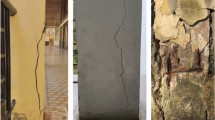Abstract
Chloride-induced corrosion of rebars and resulting spalling and sectional loss is one of the most commonly observed deterioration mechanisms in reinforced-concrete (RC) structures. Strain-hardening cementitious composites (SHCC) offer a more durable alternative to concrete; however, cost and processing considerations limit the extensive application of SHCC. A prior study by the same authors has shown the feasibility of using SHCC only in the cover of RC structures to achieve the same reduction in corrosion rates, compared to concrete, as that achieved with structures made entirely of SHCC. This study investigates the influence of pre-existing, non-corrosion-related damage on the effectiveness of SHCC cover shells in limiting the corrosion-induced deterioration of RC columns. Potentiostatic accelerated corrosion of lab-scale cylinder specimens (150 mm × 300 mm) is used to simulate the corrosion-induced damage in RC columns. Two different configurations of these cylinder specimens are used in this study: one set of specimens with pre-damaged SHCC shells and second set with intact SHCC shells. The results show that the pre-damaged and intact SHCC shells have the same corrosion rates after initial micro-cracking in the intact shell. In other words, the pre-damaged SHCC shells are as effective in reducing the corrosion rate (compared to conventional concrete) as the intact SHCC shells.
Access this chapter
Tax calculation will be finalised at checkout
Purchases are for personal use only
Similar content being viewed by others
References
Allam, I.M., Maslehuddin, M., Saricimen, H., Al-Mana, A.I.: Influence of atmospheric corrosion on the mechanical properties of reinforcing steel. Constr. Build. Mater. 8(1), 35–41 (1994)
Basheer, P., Chidiact, S., Long, A.: Predictive models for deterioration of concrete structures. Constr. Build. Mater. 10(1), 27–37 (1996)
Bazant, Z.P.: Physical model for steel corrosion in concrete sea structures–theory. J. Struct. Div. 105(ASCE 14651 Proc.) (1979)
Fasullo, E.: Infrastructure: The Battlefield of Corrosion. Corrosion Forms and Control for Infrastructure. ASTM International, West Conshohocken (1992)
Koch, G.H. et al.: Corrosion cost and preventive strategies in the United States. Federal Highway Administration (FHWA) (2002)
Lepech, M.D., Li, V.C.: Water permeability of engineered cementitious composites. Cem. Concr. Comp. 31(10), 744–753 (2009)
Li, V.C., Wang, S., Wu, C.: Tensile strain-hardening behavior of PVA-ECC. Mater. J. 98(6), 483–492 (2001)
Ranade, R., Fakhri, H., Ragalwar, K.: Feasibility of Utilizing ECC Cover to Mitigate Rebar Corrosion in Reinforced-Concrete Bridge Piers. BEFIB-9, RILEM, Vancouver, Canada, pp. 521–531 (2016)
Sahmaran, M., Li, M., Li, V.C.: Transport properties of ECC under chloride exposure. ACI Mater. J. 104(6), 604–611 (2007)
Tuutti, K.: Corrosion of Steel in Concrete. Royal Institute of Technology, Stockholm, Sweden (1982)
Wang, S., Li, V.C.: Engineered cementitious composites with high-volume fly ash. ACI Mater. J. 104(3), 233–241 (2007)
Author information
Authors and Affiliations
Corresponding author
Editor information
Editors and Affiliations
Rights and permissions
Copyright information
© 2018 RILEM
About this paper
Cite this paper
Fakhri, H., Han, Y., Ranade, R. (2018). Influence of Damage on the Effectiveness of SHCC Covers for Reducing Corrosion Rates in Reinforced-Concrete Structural Elements. In: Mechtcherine, V., Slowik, V., Kabele, P. (eds) Strain-Hardening Cement-Based Composites. SHCC 2017. RILEM Bookseries, vol 15. Springer, Dordrecht. https://doi.org/10.1007/978-94-024-1194-2_70
Download citation
DOI: https://doi.org/10.1007/978-94-024-1194-2_70
Published:
Publisher Name: Springer, Dordrecht
Print ISBN: 978-94-024-1193-5
Online ISBN: 978-94-024-1194-2
eBook Packages: EngineeringEngineering (R0)




